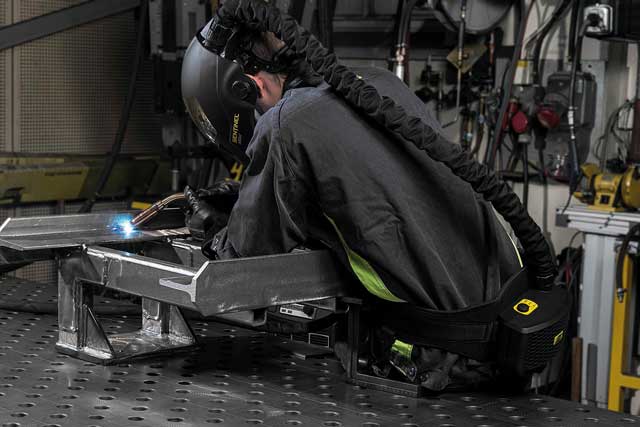
Guy Shelverton, ESAB global product manager for equipment, accessories & PPE, outlines the features to look for in a helmet
What are the factors to look for when evaluating an top-tier auto-darkening welding helmet? Start by considering these: comfort and balance; auto-darkening filter technology and size; shades and modes; sensors and batteries; and shell design.
Comfort and balance
According to ESAB’s customer research, welding operators value comfort and balance more than any other attribute. A typical welding helmet provides three points of contact. A headband provides primary contact points on the forehead and the back of the head, with a ratchet mechanism to adjust band diameter. Padding for the forehead and the back of the head may or may not be provided. To keep the helmet from slipping down, a band goes over the top of the head.
Next generation helmets have headgear that provides five points to distribute the perceived weight, such as the Halo headgear on the new ESAB Sentinel A50 helmet.
ADF technology
Perceived weight distribution is directly related to the size of auto-darkening filter. A larger viewing area requires more glass and weighs more (and incidentally costs more: the ADF typically accounts for 60 to 70% of helmet cost). Many operators say that a viewing area of approximately 100mm x 63mmn (4 in x 2.5 in) is ideal for seeing the joint, while helping reduce weight and keeping the helmet more affordable.
Many top-end lenses switch from a light to dark state at speeds of 1/25,000 of a second. The lens has a permanent passive filter to protect against UV and IR light. Even if the ADF fails to darken, the UV and IR filter helps protect the eye.
As ADF technology has advanced, there’s more difference between low- and high-end helmets. Operators need to learn how to evaluate optical clarity. The European Norm (EN) 379 standard sets performance requirements for optical quality and evaluates them on a scale of 1 to 3, with class 1 being the highest. The four factors that determine quality are:
• Optical quality 1, 2 or 3
• Light diffusion class (switchable filters only)
• Variation in luminous transmittance (switchable filters only) – indicates shade variability in the dark state of the ocular
• Angle of dependence of luminous transmittance (optional) – if applicable, marked before the standard number.
The highest optical classification is 1/1/1/1. The Sentinel A50, with a 1/1/1/2 optical class rating, offers a sharp, clear and consistent view of the weld puddle without the extra cost of obtaining a ‘1’ rating for angle dependency.
Tinted windows
Until 2008, most ADFs created a greenish cast that muddled the varying shades of red in the weld puddle and the heat-affected zone. Newer ADFs offer truer colour perception, transmitting a blue tint from the weld and helping operators to read the weld puddle and heat affected zone more easily.
The Sentinel helmet offers front lens covers in clear and amber. An amber tint can improve contrast between the weld puddle and the rest of the joint, as well as enhancing the light in low-light conditions.
ADF shade affects view the most. Older premium helmets offered a shade range of 9 to 13 whereas newer ones offer a range of 5 to 13. The lower ranges help when TIG welding at low amperage, when using small diameter electrodes at lower amperages and when plasma or oxy-fuel cutting. To prevent the operator from accidentally using a low shade number in high amperage applications, some helmets require the operator to toggle manually between low and high ranges.
Top-tier helmets also offer a “grind mode” of shade 3.5 or 4. Activating the grind mode fixes the shade of lens so that operators can grind without the sparks causing the lens to darken to a welding state. Helmets with modes for welding, cutting and grinding avoid the need for different helmets for each task. Not all helmets are rated for low-amp TIG, though, so read the technical specifications.
Sensors and batteries
Typically, ADFs have either two or four sensors located in the corners of the cartridge. Some top-tier helmets (like the ESAB Aristo Tech HD) also use electromagnetic arc sensors that automatically react to the magnetic field of the arc. This eliminates interference from sunlight or other electrical or electronic equipment, as well as ensuring that the helmet darkens when the sensors are blocked.
To change from a light to dark state, ADFs use a variety of technologies, including solar power, lithium batteries or a combination.
Shells and cover lenses
Regardless of price, all welding helmets must meet the ANSI Z87.1 (or CAN/CSA Z94.3) standard, which covers impact resistance, flame resistance and light leakage.
Welding helmets use a plastic lens to protect the ADF’s glass from spatter, smoke, scratches and impact. Some lens cover designs permit change in a matter of seconds, while others require removing the entire ADF. If an operator will be welding in situations that create a lot of spatter and smoke, this is a significant consideration.
Following the suggestions above will help guide you to an informed decision. Choosing a good helmet can improve not just the operator’s comfort, but also productivity.
Further information: t: 0800 3893152 | info@esab.co.uk.

